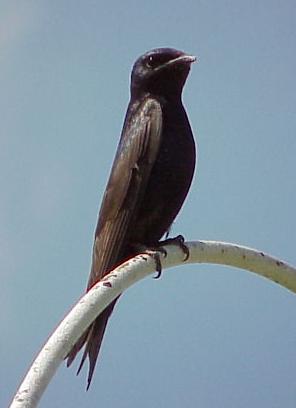PURPLE MARTINS Progne Subis - Swallow family

photo copyright James R Hill, III/Purple Martin Conservation Association. Used by permission
With their dark, iridescent blue-purple coloring, slim streamlined form and graceful gliding in flight, purple martins have a loyal following of human admirers. Purple martins spend the non-breeding season in Brazil then migrate to North America to nest. However, those purple martins that nest in regions east of the Rocky Mountains have a dramatic distinction separating them from other bird species. Their survival is totally dependent on human-supplied housing that has very specific size and aerial space requirements.
Becoming a successful purple martin “landlord” (hosting a colony of purple martins on your property) is not for the faint of heart. This pastime comes with responsibility and an important inventory of site-specific management techniques, rigorous maintenance schedules and diligence. However, most landlords would agree that the rewards of their dedication are great when a purple martin colony finds a home in their yard.
Over one million people in the U.S. claim to be purple martin landlords yet many are unable to attract and keep purple martins from year to year due to a variety of factors.
Like all swallows, purple martins are aerial insectivores, eating only flying insects that they catch in flight. They are extremely vulnerable to starvation during extended periods of cool, dry, windy or rainy weather that hinders this feeding style. Since they are so dependent on man-made housing, the placement of purple martin housing is critically important and active colony sites require careful management by their landlord. Martin houses, or better yet, gourds, which afford greater protection from predators and weather, should be painted white and should be mounted on poles with pulley systems that are designed to be raised and lowered vertically. This allows the landlord easy access to nest compartments to periodically check the nests to evict nest-competitors or clean out nest cavities. Nest checks require careful attention to return the nesting cavities to their exact position.
Purple martin housing should be at a height of 15-20 feet and located in an open space area about 30-120 feet away from any human housing. There should be no trees taller than the martin housing within 40 to 60 feet and large bodies of water or marshes nearby are an attractive bonus.
Purple martins will quickly abandon their colony site once predators invade their nests. A few visits up the pole by a snake, raccoon or squirrel or an unwelcome visit from an owl, hawk or crow will cause martins to leave the site. If housing is not adequately monitored the landlord and nonnative bird species such as house sparrows and starlings take over the site, purple martins will quickly move on.
Successful colonies of purple martins will return each year to sites that are situated in the right location and properly managed throughout breeding and nesting periods. If you are lucky enough to have a nesting colony of purple martins in your yard or near your home, you are in for a season of delight.
Credit to Connecticut Audubon Society